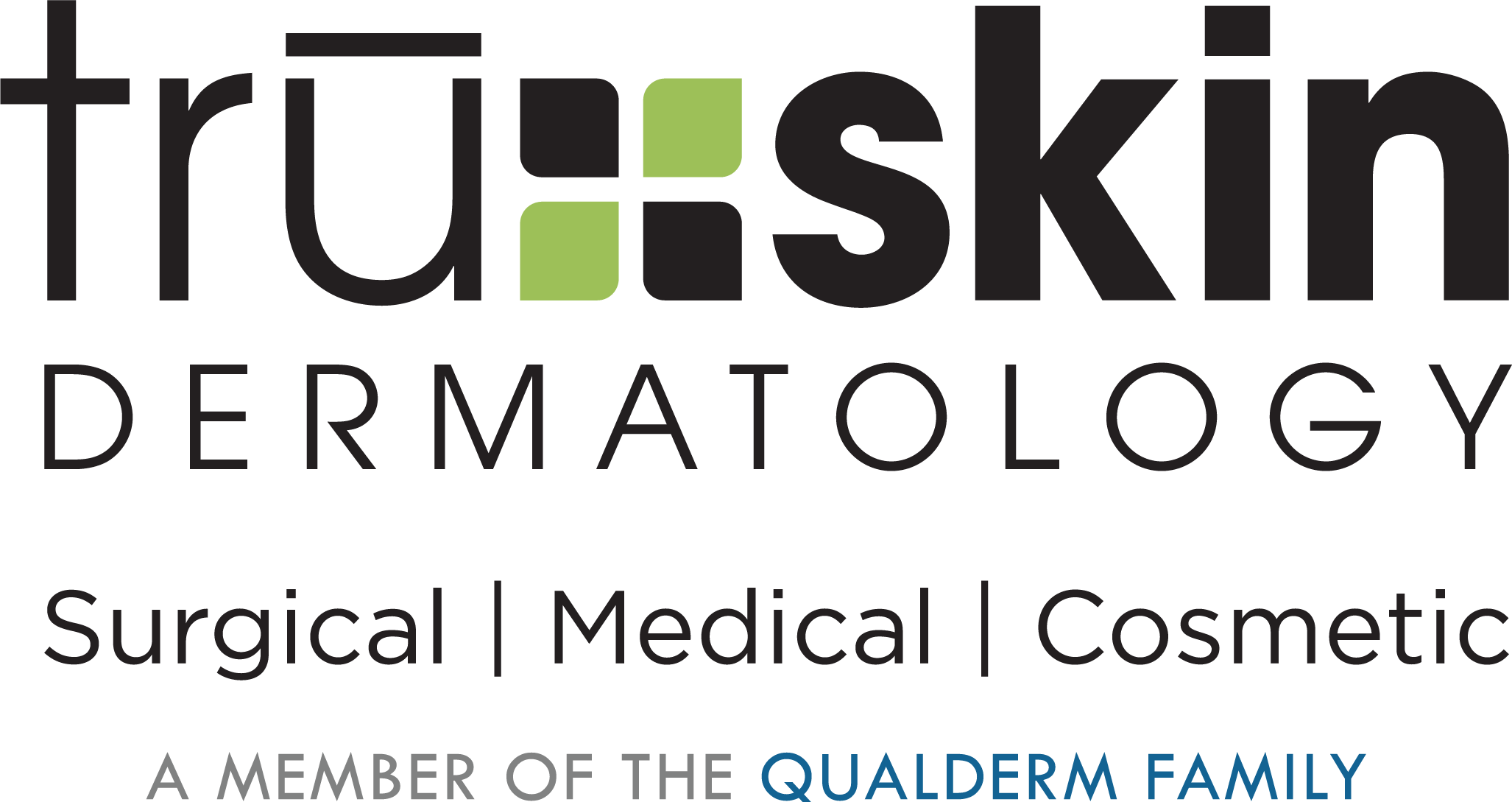Tru-Skin Dermatology Answers Questions Related to Skincare
Whether it’s your first time visiting our medical dermatology specialists, or you’ve been seeing us for years, you’re bound to have questions about issues affecting your skin. Tru-Skin Dermatology attempts to answer the most frequently asked questions encountered by our dermatologists. If we don’t address your specific question below, we encourage you to make an appointment at one of our seven conveniently located medical dermatology clinics in Central Texas. Reach out to our team today!
How Does a Dermatologist Diagnose Different Skin Problems?
Dermatologists utilize various skin tests to diagnose skin problems, ranging from skin rashes and skin allergies to cancerous cells and non-cancerous growths. Skin testing for an allergy may involve us scratching your outer layer of skin, injecting a small amount of the suspected allergen under your skin, or sticking a patch of the allergen on your skin to test your reaction. We may use other tests to determine if you have an infection or a chronic skin condition, such as psoriasis or rosacea. If you have any suspicious moles or other skin growths, we’ll likely order a biopsy to determine if it’s cancerous or non-cancerous before recommending any skin treatments.
I Have a Weird Mole on My Back/Leg/Neck/Hand. Could It Be Skin Cancer?
Most moles are not cancerous. A good guideline for self-evaluating suspicious moles or skin growths, endorsed by the American Cancer Society, is the “A, B, C, D, E” for skin cancer as follows:
- Asymmetry – Normal moles tend to be symmetrical. Skin cancers tend to be asymmetrical.
- Border – Standard moles usually have even borders. Skin cancers usually have uneven borders.
- Color – Non-cancerous moles or skin growths are a single, even color. Skin cancers can be multi-colored.
- Diameter – Moles, skin tags, and other non-cancerous skin growths tend to be less than ¼” in diameter. Skin cancers are usually larger in diameter (up to 6mm).
- Evolving – Normal moles do not grow larger or change shape. Skin cancers usually evolve.
If you’ve found a mole or skin growth fitting one or more of the above parameters, the only way to determine if it’s cancer is through a biopsy. During this procedure, a local anesthetic is applied to the area around the growth. A small section of it is cut out and sent to a lab for analysis. Tru-Skin Dermatology has performed thousands of quick, painless skin biopsies. If you suspect you may have cancer, time is of the essence. Call our clinic for a skin cancer screening today!
What’s the Difference Between Psoriasis and a Skin Rash?
Psoriasis is a long-term, chronic skin disease characterized by red, itchy, or scaly patches on your elbows, knees, scalp, face, chest, lower back, palms, and the soles of the feet. It goes beyond other common skin rashes in that it may also cause swollen or stiff joints, thickened nails, and skin so cracked and dry that it ends up bleeding. Psoriasis is an immune disorder causing severe skin rash flareups that come and go in cycles. Although more serious than other types of rashes, it tends to improve with treatment over time.
Can Tru-Skin Dermatology Cure Psoriasis with Treatment?
Though psoriasis cannot be medically cured per se, modern medical dermatology offers many options for managing the disease effectively that weren’t available in years past. Each case of psoriasis is different, so Tru-Skin Dermatology encourages you to make an appointment. We have seven clinics with experienced medical dermatologists ready to diagnose and treat your psoriasis. After evaluating your condition, we’ll prescribe a regimen of topical or oral treatments or injectable treatments, such as Humira, Enbrel, or Stelara, for more severe cases of psoriasis.
Acne Is Wrecking My Teenager’s Self-Esteem and Social Life. Help!
You can tell your teen that everyone their age goes through hormonal acne issues, and they should outgrow it. Although they’re still beautiful inside, many teens seek the best acne treatment to make them feel less ugly, unclean, or utterly alone. Fortunately, acne is highly treatable, even in cases that have proven resistant to over-the-counter pimple acne treatments. Tru-Skin Dermatology also treats cystic acne, which causes painful, severe breakouts deep in the skin when the pores are clogged by dead skin cells or bacteria. Cystic acne treatment may include prescription medications for the best results.
Is your teen suffering from acne? We invite you to schedule an appointment at the Central Texas clinic location closest to you. We also offer telehealth appointments, so you needn’t leave home. Between medical-grade topical treatments and prescription antibiotics, we’ll find the right combination of acne treatment to get your teen’s skin back to clear and their outlook on life back to positive.
What Are the Best Acne Scar Removal Treatments Available?
The best treatment for acne scars will vary by person and skin type. Some that we often recommend include laser resurfacing, microdermabrasion, chemical peels, steroid injections, injectable soft-tissue fillers, microneedling treatments, and home skincare products. Extreme cases may require surgery to minimize scarring. There is no “one-size-fits-all” solution. Schedule a consultation with one of our dermatologists to determine which acne scar removal treatment is best for you.
What Is Rosacea? Can You Treat My Severe Rosacea?
Absolutely! Tru-Skin Dermatology offers a wide range of rosacea treatment options. Rosacea is a common inflammatory skin condition causing red spots, pus-filled bumps, or visible blood vessels on the face. It’s sometimes mistaken for severe acne and typically affects women who are middle-aged or have fair skin. Even in those cases where the redness has worsened to the point of disfigurement, our cosmetic dermatologists can determine the most effective course of treatment. We may recommend prescription-grade creams or ointments and periodic IPL photofacials to rejuvenate your skin and reduce the redness. With our medical dermatology clinic’s guidance, the constant queries of “Wow, where’d you get that sunburn?” will stop.
I’m Losing My Hair, and It’s Not Normal Baldness. What Could It Be?
Any number of medications, allergies, hairstyles, and medical conditions can cause hair loss not related to genetic baldness, including, but not limited to, the following:
- Chemotherapy
- Physical or emotional shock
- Alopecia areata
- Traction alopecia from too-tight braids or ponytails worn long-term
- Hormonal changes due to pregnancy, childbirth, or menopause
- Ringworm
- Hypo/hyperthyroidism
- Medications used to treat
- Cancer
- Arthritis
- Hypertension
- Gout
- Depression
To get to the bottom of your hair loss and find effective hair loss treatment options, call Tru-Skin Dermatology to schedule a consultation. We usually begin with a clinical biopsy using skin and hair samples to identify why you’re losing hair rapidly. Depending on your situation, we may recommend oral or topical medications or Theradome™ laser hair growth treatment.
Over-the-Counter Treatments Won’t Get Rid of My Warts. Can You?
Stubborn warts warrant a visit to a medical dermatology clinic. Depending on your situation, treatment protocols we may recommend include:
- Cantharidin – This is a topical medication that causes a blister to form under the wart, so your dermatologist can easily clip it off later.
- Cryotherapy – Cryotherapy, or “freezing” a wart off, is a common, safe way to treat stubborn warts.
- Electrosurgery and Curettage – Electrosurgery (burning) and curettage (scraping or cutting off) can be used alone, in combination, or even in reverse order to get rid of facial (filiform) or foot (plantar) warts.
- Excision – This treatment involves cutting the wart out altogether.
Laser skin resurfacing may also be used if your warts prove hard to treat. Warts can become disfiguring or debilitating if left untreated, so call Tru-Skin Dermatology today.
What Are My Best Options for Getting Rid of Wrinkles?
While you can’t ever get rid of skin wrinkles permanently, Tru-Skin Dermatology can make you look as though you did! We offer many medical and cosmetic dermatology treatments for easing fine lines and wrinkles. Some treatments are temporary, while others last a few months or even years. These include, but aren’t limited to:
- Cosmetic injectables, including:
- BOTOX®
- Juvéderm®
- Kybella®
- Dysport®
- Xeomin®
- Restylane®
- SkinPen treatments
- Chemical peels
- Microdermabrasion
- Photofacials
- tru-Express and tru-Signature facials
Call one of our seven cosmetic dermatology clinics to determine which method suits your goals and budget the best.
Do I Need a Referral to Visit a Tru-Skin Dermatology Clinic?
You don’t typically need a referral to be seen at our clinics. However, some insurance providers may require a referral or prior authorization from your physician to cover our services. Be sure to check with your specific insurance provider before scheduling an appointment to see our medical dermatology specialists in Austin, Bastrop, La Grange, Spring Branch, Cedar Park, Hallettsville, or Round Rock today. We accept new patients of all ages. If you’re a new patient, you may download our patient forms online prior to your appointment. Same-day and next-day appointments are sometimes available. Just ask!

